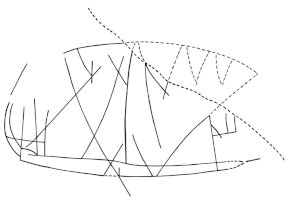Round hulled merchant ship to the right. The hull is a single thick continuous band, with a high vertical stempost and a high curving sternpost ending in a stylized bird-headed device facing inboard. Its head and beak are still very distinguishable but there is no eye as on the Nicosia vessel. The forecastle and aftercastle are rendered differently. The former appears to have a rectangular frame with two vertical bars inside, while the latter seems to be formed by five individual railings. The two steering oars have rectangular oar blades with rounded edges. The mast is amidships, with the yard rendered as a generally straight horizontal line raised to the top of the mast and extending the entire length of the ship, with one of its ends touching the top of the stempost. The semicircles below the yard denote that the sail is furled. There are two halyards and two brailing ropes which cross each other, forming an X on each side of the mast. The solid triangle at the base of the mast must be the mast-step system which secured it in place. The same feature is observable on the Nicosia ship except on a much smaller scale.
Merchant ship
C5
c. 750-600 B.C. (Cypro Archaic I)
Said to be from Ormidhia
H: 23.2 cm
White Painted IV jug
Basch 1987: 259, no. 567; Cesnola 1877: pl. XLV, fig. 37; 1894: pl. CXXIX.964; Hagy 1986: 230, Fig. 11; Karageorghis and Des Gagniers 1974(vol.1): 38, 121, 146, no. XI.3; 1974(vol.2): 123, no. XI.3; Karageorghis *et al* 2000: 95, no. 154; Wachsmann 1998: 183-84, fig. 8.41b; Westerberg 1983: 45, 55-57, 59, 66, no. 55, fig. 55
The vessel shares important features with the other two Cypro Archaic I ship representations, most notably the bird-headed device, the mast-step system, the furled sail and the vertical stempost.
Basch, L. 1987. Le musée imaginaire de la marine antique. Athens: Institut Hellénique pour la preservation de la tradition nautique.
Cesnola, L.P. di. 1877. Cyprus: its ancient Cities, Tombs, and Temples: a Narrative of Researches and Excavations during ten Years’ Residence as American Consul in that Island. London: John Murray.
―――. 1894. A Descriptive Atlas of the Cesnola Collection of Cypriote Antiquities in the Metropolitan Museum of Art, New York. Vol. 2. Boston: James R. Osgood and Company.
Hagy, J. W. 1986. “800 Years of Etruscan Ships,” IJNA 15: 221-250.
Karageorghis, V. and J. Des Gagniers. 1974. La céramique chypriote de style figuré. Âge du Fer (1050-500 av. J.-C.). Roma: Istituto per gli Studi Micenei ed Egeo-Anatolici.
Wachsmann, S. 1998. Seagoing Ships & Seamanship in the Bronze Age Levant. College Station, TX: Texas A&M University Press.
Westerberg, K. 1983. Cypriote Ships from the Bronze Age to c. 500 B.C. (SIMA, Pocket-books, 22). Göteborg: P. Åströms förlag.






